Classical animation or Traditional Animation is a technique where each frame was drawn by hand. The technique was the dominant form of animation in cinema until the advent of computer animation. It has been around for over 100 years. With the rise of Walt Disney in 1930s and other talented animators, the floodgates opened and this field rose to prominence. Animation went through many stages as it had major upheavals in response to changing audience tastes and technology. Eventually with the origin of computer animations, It designed the world richly with amazing depths of colour and detail. This is only due to the efforts of great animators, who was merely dedicated to their work, and their efforts brought forth a new 3D world. Lets discuss the few legend animators and their contribution to this 3D World.
Peter Mark Roget:
Origin: British
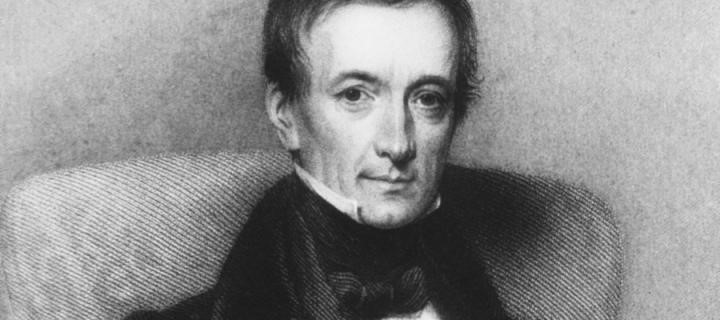
Peter Mark Roget was a British physician, natural theologian and lexicographer. He is best known for his publishings. In 1824 Peter Mark Roget presented his paper ‘The Persistence of Vision with Regard to Moving Objects’ to the British Royal Society. His investigations were part of widespread interest in the ‘wheel phenomenon’ — the illusion of the spokes of a rapidly turning wheel seeming to turn forward or backwards of stand still at different times. He described the important fact that the human eye blends a series of sequential images into a single motion if the images are presented rapidly, with sufficient illumination and interrupted regularly. It was the fact which allowed animation to be possible. Because of this discovery the animation or moving pictures had begun. He created the thaumatrope in 1825, which when spun the two complimentary images appear to merge, creating the very first “motion picture”.
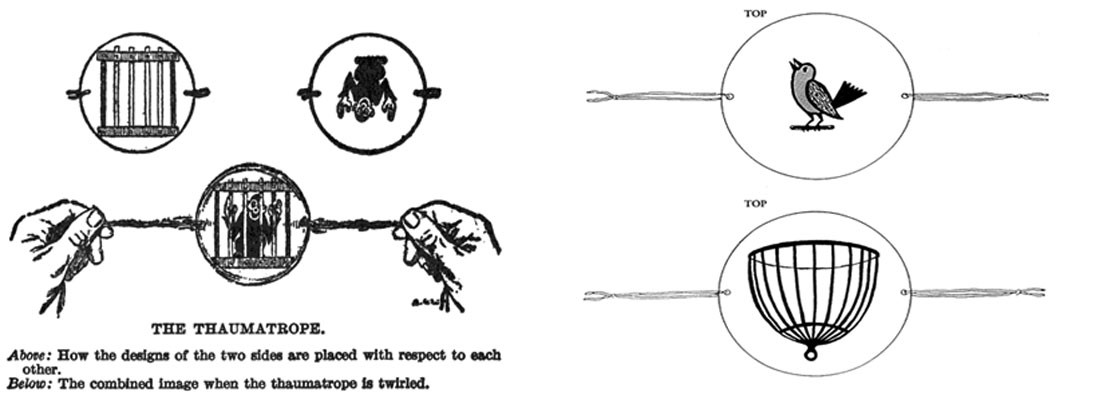
Earl Hurd:
Origin: American

Earl Hurd was a pioneering American animator and film director. He is noted for creating and producing the silent Bobby Bumps animated short subject series for early animation producer J.R. Bray’s- Bray Productions. In 1914 Earl Hurd received a patent for his innovation of using clear sheets of celluloid (cels), which eliminated the need to redraw background scenes, since sheets containing various movements could be laid on top of one another.
Contribution in Animation:
Earl Hurd created a silent animated series named “Bobby Bumps” produced by Bray Productions. Bobby Bumps was a little boy who, accompanied by his dog Fido, regularly found himself in and out of mischief. The cartoons were released by Paramount Pictures and directed and animated by Earl Hurd.
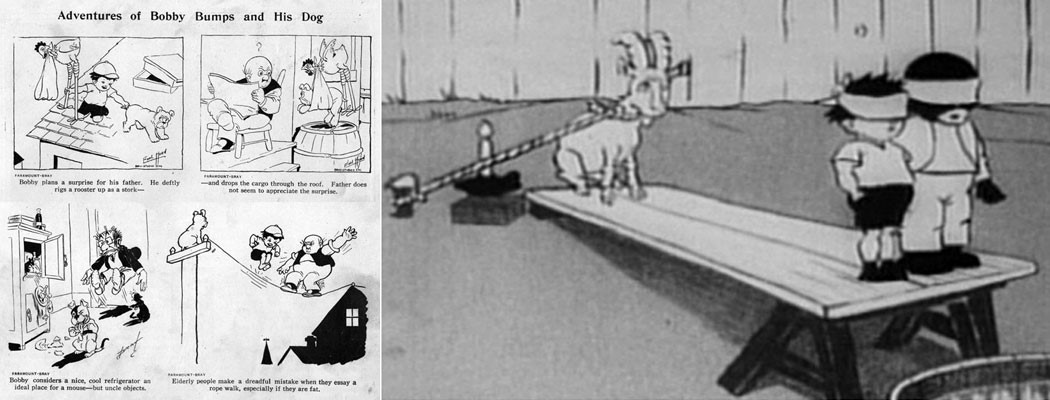

The Bobby Bumps cartoons were the first to be produced using the cel animation process. Previously, animated cartoons were produced using paper animation: a new drawing was made for each frame of film. With cel animation, he drew his characters on clear sheets of celluloid, which he placed over still backgrounds during the photography process. Cel animation revolutionized the animation industry, and Hurd held a patent for the process (received licensing payments from all studios using the process) until 1932.
Raoul Barré:
Origin: Canadian and American
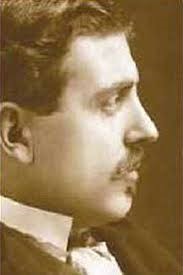
Raoul Barre’ was a artistic child and pioneer of cartoons. He went to Paris to study at the School of Fine Arts and remained there for several years as a political cartoonist. In 1902 he created the first French-Canadian comic strip, “For a Christmas Dinner” of eight episodes. It inspired other local cartoonists to try their hand at the new medium. The following year Barré moved to New York City to work as a commercial illustrator while drawing two comic strips for Montreal papers, “The Adventures of Timothy (1904 to 1909) and “Father Ladebauche” (1904 to 1909).
In 1912, Barré saw an animated film that inspired him to go into the animation industry. He picked Edison Studios to produce his cartoons and while visiting the studio, met Bill Nolan, a live-action shorts producer who became his business and artistic partner. The two worked together for a year putting out animated and live-action commercials for various companies. With the collaboration of each other, they found their own Barré Studio in 1914. This was the world’s first professional animation studio. They worked using different techniques and produced cartoon series “Animated Grouch Chaser” and “The Boob Weekly”.
In 1916 newspaper baron, William Randolph Hearst started the rival International Film Service and hired away most of Barré’s staff, including Nolan. Barré accepted some Hearst assignments as an independent contractor and then quit the job. Barre’ then formed a new partnership with cartoonist Charles Bowers, producing short comic strips based on Bud Fisher’s “Mutt and Jeff”.


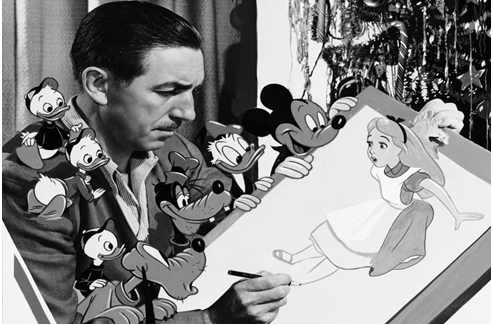
To get the films out Barré trained a new group of enthusiastic young artists, some of whom – Walter Lantz, Bill Tytla, Frank Moser, Dick Huemer – who later became legends in their field. But there was friction between him, Bowers and Fisher, and Barré abruptly quit in 1918. After working for an advertising agency, he reappeared in 1926 as an animator on Pat Sullivan’s “Felix the Cat” cartoons.
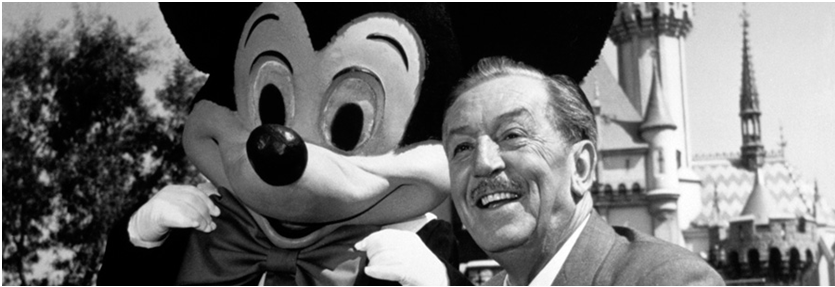
In last years of his life, he revived his skills as an editorial cartoonist to aid the political career of his son-in-law.
Walter Elias:
Origin: American
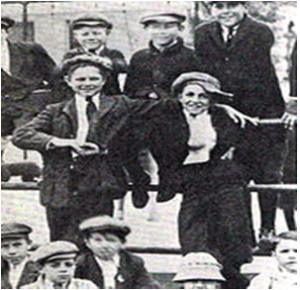
Walter Elias was an American animator, film producer, director, screenwriter, voice actor, entrepreneur, entertainer, international icon, and philanthropist, well known for his influence in the field of entertainment during the 20th century.

Walter Elias Disney was born in Chicago. He had a very early interest in drawing, and art. When he was seven years old, he sold small sketches, and drawings to nearby neighbours. Instead of doing his school work Walt doodled pictures of animals, and nature. His interest in trains also developed while working with his uncle who was a engineer at railway station. Walt would put his ear to the tracks in anticipation of the coming train, spotting his uncle to conduct the train.
In 1917, Walt attended McKinley High School in Chicago. There, he divided his attention between drawing and photography and took night courses at Chicago Art Institute to better his drawing abilities. He became the cartoonist for the school newspaper, drawing patriotic topics and focusing on World War I. He began to entertain his friends by imitating his silent screen hero, Charlie Chaplin. At his teachers invitation, Walt would tell his classmates stories, while illustrating on the chalk board. Later on, against his fathers permission,
Walt would sneak out of the house at night to perform comical skits at local theaters. After attending high school, he joined army for a very short period and then joined Red Cross. After four years, He was sent to France where he drove an ambulance. His ambulance was covered from stem to stern, not with stock camouflage, but with Disney cartoons.

When he returned back from France, he wanted to pursue a career in commercial art, which soon lead to his experiments in animation. He began producing short animated films for local businesses, in Kansas City. By the time Walt had started to create The Alice Comedies, which was about a real girl and her adventures in an animated world. When Walt ran out of money, he packed his suitcase with his unfinished print of The Alice Comedies in hand, headed for Hollywood to start a new business.
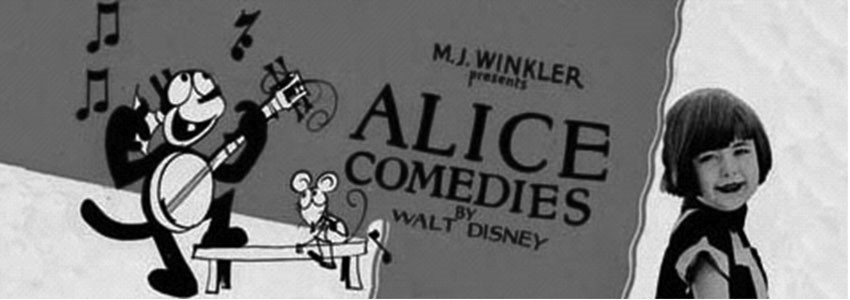

Walt with his brother, Roy O. Disney set up a shop in their uncle’s garage at the rear of Hollywood real estate office. Soon, they received an order from New York for the first Alice in Cartoonland (The Alice Comedies)feature film.


Although, Walt wasn’t the typical Hollywood tycoon. His talents were first used in a silent cartoon entitled Plane Crazy. However, before the cartoon could be released, sound was introduced upon the motion picture industry.
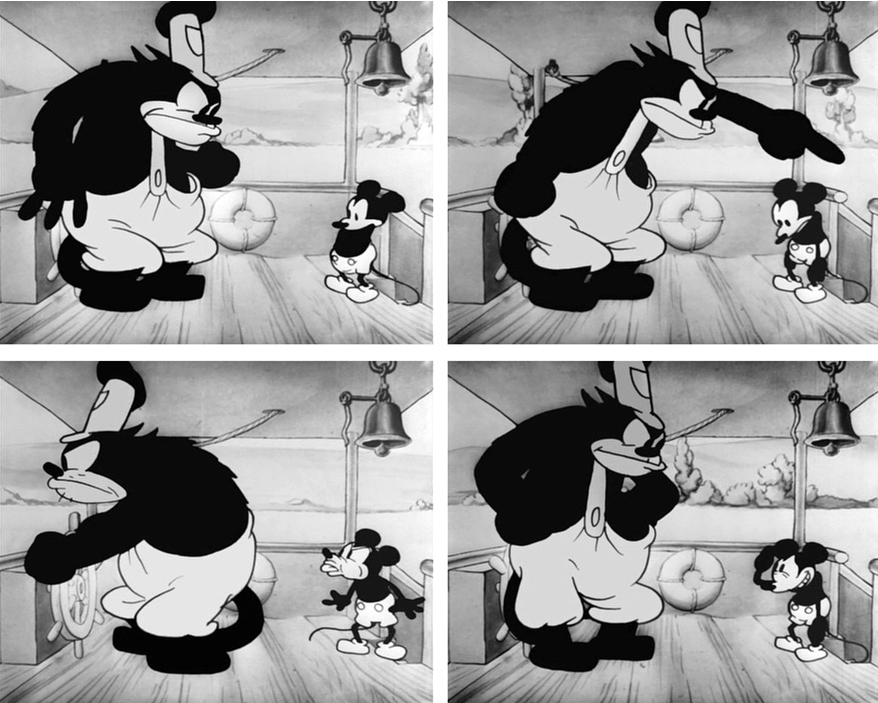
Thus, Mickey Mouse made his screen debut in Steamboat Willie, the world’s first synchronized sound cartoon, which premiered in New York, 1928. In 1932, Disney received a special Academy Award for the creation of “Mickey Mouse”, a series which switched to color in 1935 and soon launched spin-offs for supporting characters such as Donald Duck, Goofy, and Pluto.
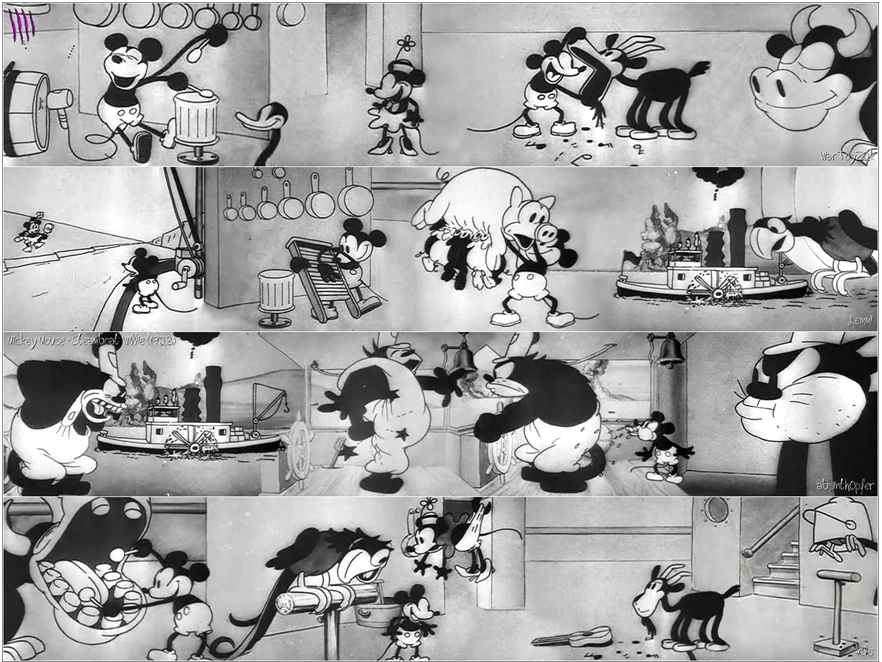
Technicolor was introduced to animation during the production of his Silly Symphonies Cartoon Features. Walt Disney held the patent for Technicolor for two years, allowing him to make the only color cartoons.

In 1932, the feature entitled Flowers and Trees won the academy award. In 1937, he released The Old Mill, the first short subject to utilize the multi-plane camera technique.

Snow White and the Seven Dwarfs, the first full-length animated musical feature, was released in Los Angeles. This cartoon film is still considered one of the great feats and imperishable monuments of the motion picture industry. During the next five years, Walt Disney Studios completed other full-length animated classics such as Pinocchio, Fantasia, Dumbo, and Bambi.

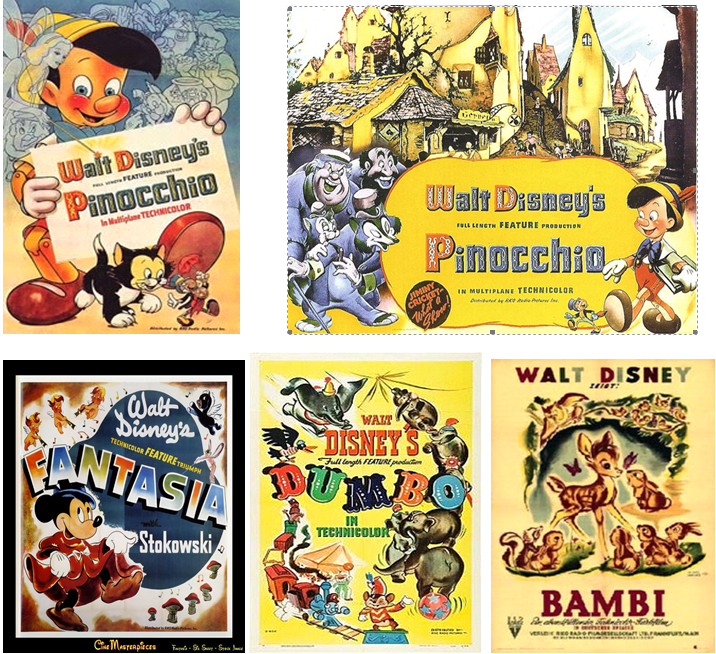
In 1940, Disney’s staff swelled to more than 1,000 artists, animators, story men, and technicians. Because of World War II 94 percent of the Disney facilities were engaged in special government work, including the production of training and propaganda films for the armed services, as well as health films which are still shown through-out the world by the U.S. State Department. His efforts were devoted to the production of comedy short subjects which were highly essential for civilians and military people. In 1945, disney’s feature The Three Caballeros and Mary Poppins combined live action with the cartoon animation which itself was a success for disney studio.
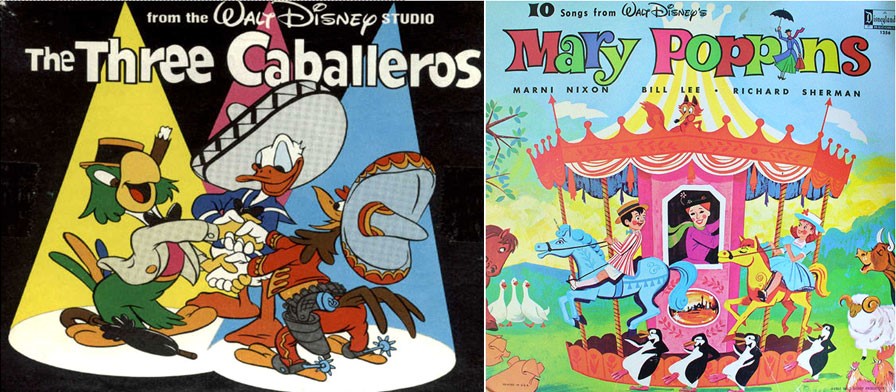
After 1945, disney studios created unlimited inexpensive package films, containing collections of cartoon shorts, and issued them to theaters during this period. These included Make Mine Music , Melody Time, Fun and Fancy Free, The Adventures of Ichabod, Mr. Toad, The Wind in the Willows, The Legend of Sleepy Hollow, Song of the South and So Dear to My Heart.
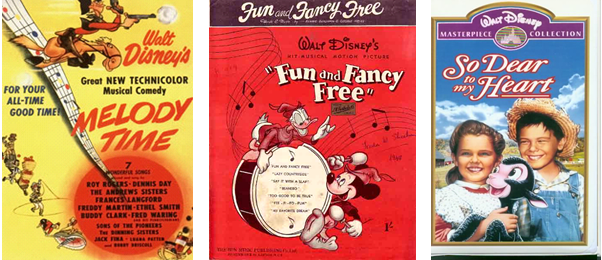


The studio had recovered enough to continue production on the full-length features Alice in Wonderland, Peter Pan and Cinderella which became Disney’s most successful film since Snow White and the Seven Dwarfs. The studio also initiated a series of live-action nature films, titled True-Life Adventures. During the mid-1950s, Disney produced educational films on the space program in collaboration with NASA. More than 368 feature films have been released since 1937 under the Walt Disney Pictures film label. Walt Disney’s dream of a clean and organized amusement park came true in 1955 as Disneyland Park in California

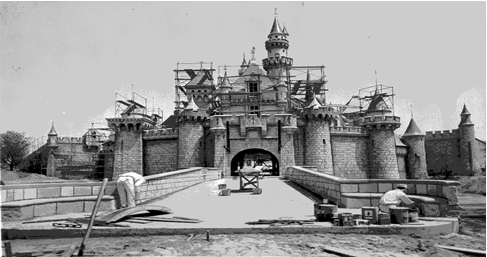
In late 1965, Disney announced plans to develop another theme park to be called Disney World in Florida. Disney World was to include the Magic Kingdom, a larger, more elaborate version of Disneyland.

After the dealth of walt Disney, Roy O. Disney took full control of Disney Productions and continued with the Florida project changing the name Walt Disney World in honor of his late brother. Today, Walt Disney’s studios and Disney theme parks have developed into a multi-billion dollar television, motion picture, vacation destination and media corporation. Among other assets The Walt Disney Company owns five vacation resorts, eleven theme parks, two water parks, thirty-nine hotels, eight motion picture studios, six record labels, eleven cable television networks, and one terrestrial television network.










